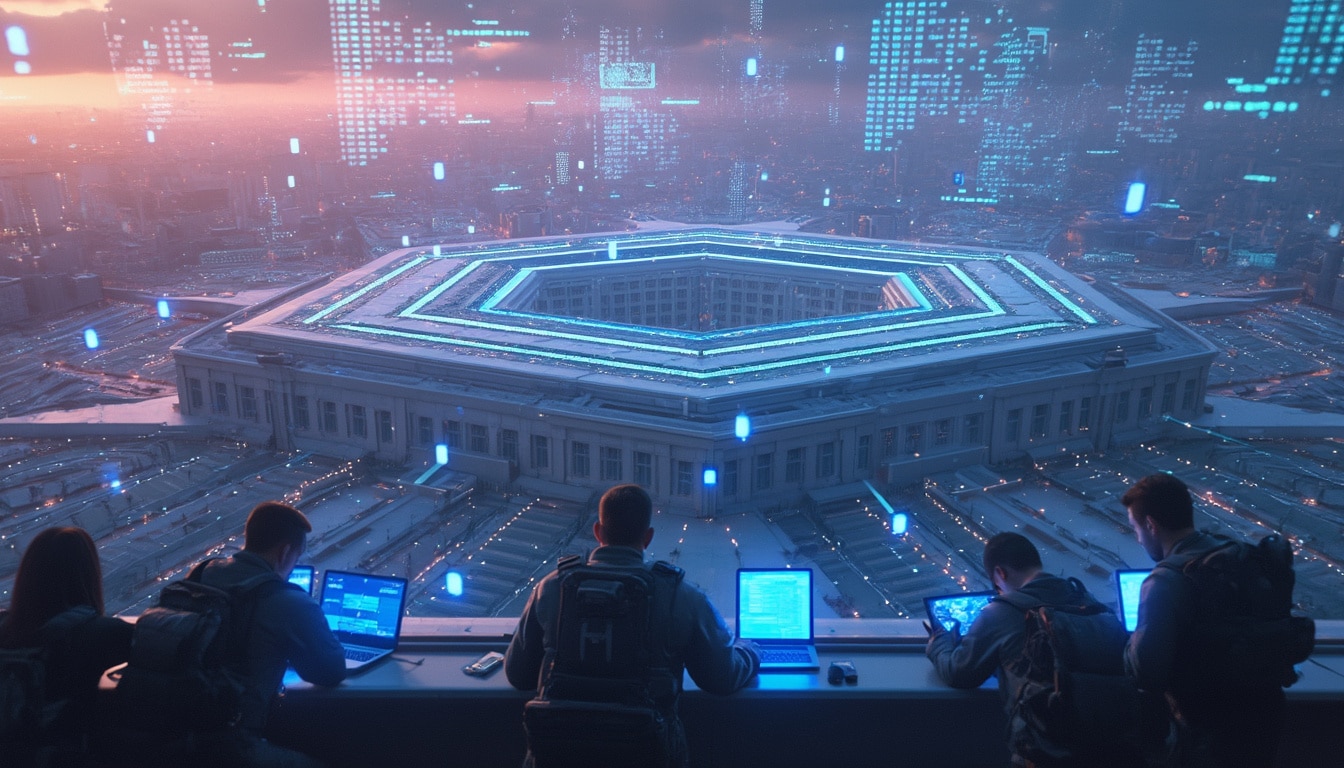Cyber threats are becoming a more complex challenge for our critical infrastructures every day.In the digital age, security is no longer an option, but a vital necessity.Geopolitical tensions exacerbate these issues, making data protection essential.
In light of this reality, the U.S. Department of Defense unveils its enhanced strategy for 2024 aimed at protecting suppliers against digital sabotage. This initiative responds to a rise in cyberattacks targeting key sectors such as military production and supply chains. The main objectives include widespread adoption of best practices in cybersecurity, safeguarding supply chains essential to military manufacturing, and improving communication between the public and private sectors.
David McKeown, the deputy director of information systems for cybersecurity at the Pentagon, emphasizes the strategic importance of these measures. “Our adversaries recognize the strategic value of targeting the defense industrial base,” he states. Indeed, suppliers and contractors within the department are constantly under threat from online harassment and foreign influences, particularly from Russia and China, which seek to acquire U.S. confidential designs.
Federal agencies such as the National Security Agency and the FBI recently revealed that hackers have succeeded in infiltrating corporate networks, maintaining persistent access and exfiltrating sensitive information. These incidents not only compromise national security but also jeopardize critical military projects, such as the development of anti-ship missiles.
Considered critical infrastructures alongside water services, food, and health systems, Pentagon businesses face frequent attacks. McKeown stresses the formidable power of hackers: “Today, especially in the United States, everyone must recognize the power of the hacker. This has been proven time and time again.”
This cybersecurity strategy fits within the broader guidelines of the department, including the National Defense Strategy of 2022 and the National Cybersecurity Strategy of 2023. With a projected budget of $14.5 billion for cyber activities in 2025, a notable increase from previous years, the Pentagon demonstrates its firm commitment to strengthening national digital defense.

In the digital age, cybersecurity has become an absolute priority for nations around the world. The Pentagon, aware of the growing threats to its critical infrastructures, has unveiled an ambitious strategy aimed at strengthening the defense of American industry against cyberattacks. This initiative comes as cyber threats continue to evolve, jeopardizing the essential supply chains for military manufacturing.
Table des matières
ToggleWhat are the main objectives of the Pentagon’s new cybersecurity strategy?
The U.S. Department of Defense has published the 2024 Defense Industrial Base Cybersecurity Strategy, a detailed roadmap aimed at protecting defense suppliers from digital sabotage. This strategy is based on four major objectives:
- Widespread adoption of best practices in cybersecurity: Encourage companies to implement robust security protocols to prevent intrusions.
- Preservation of critical supply chains: Ensure the continuity of military manufacturing by securing essential components.
- Improving communication between the public and private sectors: Facilitate information sharing and collaboration for more effective defense.
- Strengthening incident response capabilities: Develop responsive mechanisms to quickly counter cyberattacks.
According to David McKeown, the deputy director of information for cybersecurity at the Pentagon, “Our adversaries understand the strategic value of targeting the defense industrial base. We have, at the departmental level, begun to pay much more attention to it and engage in discussions with companies.”
How does the Pentagon collaborate with private companies to strengthen cybersecurity?
The close collaboration between the Pentagon and the private sector is essential for the effective implementation of the new strategy. This synergy aims to share critical information on emerging threats and harmonize security standards. For example, initiatives like cybersecurity in defense aim to raise awareness among companies about the specific challenges of protecting military infrastructures.
Furthermore, the Pentagon is investing heavily in training and awareness programs to ensure that companies possess the necessary skills to identify and neutralize cyber threats. This proactive approach is crucial in a landscape where attacks can come from various actors, including nation-states like Russia and China, which frequently target American companies for their sensitive designs.
What are the major challenges the Pentagon faces in implementing this strategy?
Despite clear objectives, several challenges persist in achieving this cybersecurity strategy. One of the main obstacles is the constancy of threats and the speed at which they evolve. Cyber attackers constantly innovate, making it difficult to establish permanent and effective defenses.
Another major challenge lies in the coordination between different government agencies and private actors. The need for smooth communication and close collaboration is crucial for a unified response to sophisticated attacks. Additionally, protecting critical supply chains requires constant vigilance to avoid vulnerabilities that could be exploited by malicious engineers.
Finally, funding represents a significant issue. With a budget of $14.5 billion allocated for cyber activities for the fiscal year 2025, the Pentagon must ensure that these funds are used effectively to maximize the impact of the security measures implemented.
What are the expected benefits of this reinforced strategy for the defense industry?
The implementation of this cybersecurity strategy aims to provide increased protection to defense suppliers, thereby ensuring the stability and resilience of military supply chains. By adopting rigorous cybersecurity practices, companies can reduce the risk of costly disruptions and compromises of sensitive data.
Moreover, improved communication between the public and private sectors allows for a quicker and more coordinated response to cyber incidents. This results in an enhanced ability to identify and neutralize threats before they cause significant damage.
In the long term, this strategy also contributes to strengthening the competitiveness of the American defense industry on the global stage. By ensuring a secure infrastructure, the United States can maintain its technological edge and its position as a leader in the military domain.
What is the importance of links with other national cybersecurity strategies?
The Pentagon’s cybersecurity strategy is part of a broader framework encompassing several national directives. It aligns with the National Defense Strategy 2022, the National Cybersecurity Strategy 2023, and the National Defense Industrial Strategy of this year. This alignment ensures a coherent and integrated approach to national security, where each strategy supports the others for comprehensive protection.
For instance, how the armed forces shape our security and our future is a central aspect of this overarching strategy, highlighting the importance of synergy between the various branches of defense and industrial partners.
What investments does the Pentagon plan to support this strategy?
The budget allocated for the development of cyber capabilities demonstrates the Pentagon’s commitment to strengthening its digital defense. For fiscal year 2025, $14.5 billion has been earmarked for cyber activities, representing an increase of around $1 billion compared to previous requests from the Biden administration. These funds are intended to finance advanced technologies, research and development programs, as well as training and recruitment initiatives for cybersecurity talent.
A key aspect of this investment lies in supporting current trends in air defense, where the protection of operational command systems is crucial for military superiority. By strengthening digital defenses, the Pentagon not only ensures the security of existing infrastructures but also prepares the ground for future innovations.
How does this strategy influence the perception and preparedness against cyber threats?
The Pentagon’s recognition of the seriousness of cyber threats changes the game in terms of preparedness and response. By stating that “in this era, especially in the United States, everyone should believe in the power of the hacker,” David McKeown highlights the importance of taking every intrusion attempt seriously. This awareness fosters a culture of vigilance and anticipation, where companies and institutions are encouraged to adopt robust preventive measures.
Moreover, by integrating lessons learned from past cyberattacks, such as those perpetrated by Chinese entities against Navy contractors, the Pentagon continually sharpens its defense strategies. These experiences enrich the understanding of adversary tactics and allow for adjustments to defenses accordingly.
What are the impacts on national and international security?
Strengthening the cybersecurity of the defense industry has significant repercussions for both national and international security. On a national level, this ensures the protection of sensitive data and critical infrastructures, thereby avoiding potential vulnerabilities that could be exploited by enemies. This protection is essential to maintaining military capability and the sovereignty of the United States against external threats.
On an international scale, such a strategy positions the United States as a leader in combating cybercrime and digital sabotage. By sharing information and collaborating with other nations and international organizations, the Pentagon helps create a united front against transnational cyber threats. This not only enhances overall security but also encourages global standards in cybersecurity.
What do experts say about this new approach?
Cybersecurity experts praise this initiative as a crucial step towards a more resilient and proactive defense. They emphasize the importance of increased investment and public-private collaboration, while highlighting that the speed of responses to threats remains an area for improvement. Furthermore, some suggest that integrating emerging technologies, such as artificial intelligence and machine learning, could further strengthen digital defenses.
Additionally, recent case studies, such as the one mentioned in Six questions to ask Mark Kitz during his change of executive offices in the army, illustrate the challenges and opportunities associated with the implementation of such strategies. These testimonies provide valuable insights into best practices and lessons learned, contributing to the ongoing improvement of security measures.
What perspectives does this strategy offer for the future of digital defense?
The Pentagon’s cybersecurity strategy paves the way for a new era of advanced and integrated digital defenses. By investing in cutting-edge technologies and strengthening sector collaborations, the Pentagon positions itself to anticipate and counter tomorrow’s cyber threats. This forward-looking vision ensures not only the protection of current infrastructures but also paves the way for future innovations in the defense sector.
Moreover, this strategy underscores the importance of a dynamic and adaptable approach to a constantly evolving threat landscape. By focusing on resilience and the ability to adapt quickly, the Pentagon ensures that the defense industry remains robust in the face of emerging challenges.
To learn more about the different facets of defense and cybersecurity, you can consult the following articles:
- Cybersecurity in defense: challenges and strategies to protect our infrastructures
- How do the armed forces shape our security and our future?
- Rising interest in the operational command system of the army
- Six questions to ask Mark Kitz during his change of executive offices in the army
- Current trends in air defense

























